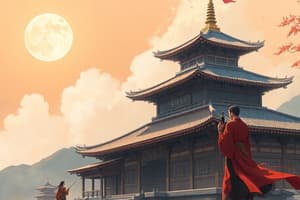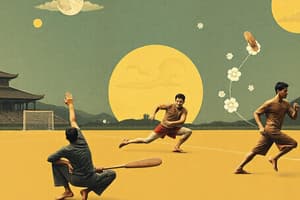Podcast
Questions and Answers
What was one of the primary reasons Korean women faced restrictions on their rights after 1300?
What was one of the primary reasons Korean women faced restrictions on their rights after 1300?
- Confucian ideals emphasized women's integration into the husband's family. (correct)
- Women were encouraged to remarry freely.
- Cultural influences from China promoted female rights.
- Their family structure favored independence.
Which of the following statements about Vietnamese political structure after gaining independence is true?
Which of the following statements about Vietnamese political structure after gaining independence is true?
- They entirely abandoned Chinese governance systems.
- Vietnam remained completely isolated from Chinese influence.
- They rejected the Mandate of Heaven.
- Chinese became the language for official business. (correct)
What unique characteristic describes Japan's approach to cultural borrowing from China?
What unique characteristic describes Japan's approach to cultural borrowing from China?
- Japan adopted all Chinese practices without modification.
- Japan had no interaction with Chinese civilization.
- Cultural borrowing was selective and voluntary. (correct)
- Japan was ruled by Chinese officials for centuries.
Which social class emerged in Japan as a result of local decentralization?
Which social class emerged in Japan as a result of local decentralization?
What was the status of slavery in Korea during the early 1100s?
What was the status of slavery in Korea during the early 1100s?
Which philosophy had a significant impact on the government structure in Vietnam after their independence?
Which philosophy had a significant impact on the government structure in Vietnam after their independence?
Which of the following was NOT a cultural element borrowed by Japan from Chinese civilization?
Which of the following was NOT a cultural element borrowed by Japan from Chinese civilization?
What was a significant economic factor in the growth of the Song Dynasty?
What was a significant economic factor in the growth of the Song Dynasty?
What was the general attitude of Chinese officials towards Vietnam during their rule?
What was the general attitude of Chinese officials towards Vietnam during their rule?
Which of the following innovations was essential to the economic prosperity of the Sui Dynasty?
Which of the following innovations was essential to the economic prosperity of the Sui Dynasty?
What was a consequence of the return of Confucianism during the Song Dynasty?
What was a consequence of the return of Confucianism during the Song Dynasty?
What was foot binding associated with in the context of Song Dynasty society?
What was foot binding associated with in the context of Song Dynasty society?
Which phrase best describes the tribute system in relation to Chinese views of northern nomads?
Which phrase best describes the tribute system in relation to Chinese views of northern nomads?
What was a significant agricultural product that flourished in China during the period of the Song Dynasty?
What was a significant agricultural product that flourished in China during the period of the Song Dynasty?
Which dynasty is recognized as the 'Golden Age' of Chinese achievement?
Which dynasty is recognized as the 'Golden Age' of Chinese achievement?
How did the relationship between China and northern nomads primarily manifest?
How did the relationship between China and northern nomads primarily manifest?
What was a major disadvantage for women in Korea due to Chinese Confucian influences?
What was a major disadvantage for women in Korea due to Chinese Confucian influences?
What did the Grand Canal primarily connect in China?
What did the Grand Canal primarily connect in China?
Which of these was a method used by the Chinese to keep nomadic tribes at bay?
Which of these was a method used by the Chinese to keep nomadic tribes at bay?
What economic activity were women in the Song Dynasty increasingly limited in?
What economic activity were women in the Song Dynasty increasingly limited in?
What cultural aspect did the Tang Dynasty provide to the Song Dynasty concerning women's rights?
What cultural aspect did the Tang Dynasty provide to the Song Dynasty concerning women's rights?
What percentage of the world's Muslim population is estimated to be Shia?
What percentage of the world's Muslim population is estimated to be Shia?
What were the monsoon winds important for in Indian Ocean trade?
What were the monsoon winds important for in Indian Ocean trade?
Which empire is known for its bureaucratic government and military forces that secured the seas?
Which empire is known for its bureaucratic government and military forces that secured the seas?
Which of the following is NOT listed as a major agricultural product that spread from South and Southeast Asia?
Which of the following is NOT listed as a major agricultural product that spread from South and Southeast Asia?
Which of the following statements about the spread of Islam is true?
Which of the following statements about the spread of Islam is true?
What factor contributed significantly to the growth of the Khmer Kingdom?
What factor contributed significantly to the growth of the Khmer Kingdom?
Which Southeast Asian state was characterized by indigenous traditions rather than the caste system?
Which Southeast Asian state was characterized by indigenous traditions rather than the caste system?
Which of the following statements correctly describes the Indian Ocean Trade routes?
Which of the following statements correctly describes the Indian Ocean Trade routes?
What is the primary focus of the Bushido code in samurai culture?
What is the primary focus of the Bushido code in samurai culture?
Which of the following is NOT one of the seven virtues of Bushido?
Which of the following is NOT one of the seven virtues of Bushido?
What significant change occurred regarding the status of women in Japan after the 12th century?
What significant change occurred regarding the status of women in Japan after the 12th century?
Which Islamic political entities emerged as the Abbasid Caliphate fragmented?
Which Islamic political entities emerged as the Abbasid Caliphate fragmented?
What contributed significantly to the spread of Islam across Afro-Eurasia?
What contributed significantly to the spread of Islam across Afro-Eurasia?
What was Muhammad's primary claim about his religious experience?
What was Muhammad's primary claim about his religious experience?
Which aspect was NOT a focus of intellectual development in Muslim states?
Which aspect was NOT a focus of intellectual development in Muslim states?
How did upper-class women in Japan differ from women under Chinese Confucianism?
How did upper-class women in Japan differ from women under Chinese Confucianism?
Flashcards
Filial Piety
Filial Piety
The principle of showing deep respect and obedience to one's parents and elders, considered a cornerstone of traditional Chinese culture.
Song Dynasty (960-1279)
Song Dynasty (960-1279)
A period in Chinese history marked by economic revolution, growth of commercialization, and flourishing of arts and culture.
Champa Rice
Champa Rice
A fast-growing and high-yield rice variety that became a key factor in China's agricultural prosperity during the Song Dynasty.
Grand Canal
Grand Canal
Signup and view all the flashcards
Imperial Bureaucracy
Imperial Bureaucracy
Signup and view all the flashcards
Foot Binding
Foot Binding
Signup and view all the flashcards
Patriarchal Restrictions
Patriarchal Restrictions
Signup and view all the flashcards
Tribute System
Tribute System
Signup and view all the flashcards
Northern Nomads
Northern Nomads
Signup and view all the flashcards
Silk Road
Silk Road
Signup and view all the flashcards
Great Wall of China
Great Wall of China
Signup and view all the flashcards
Confucianism
Confucianism
Signup and view all the flashcards
Han Dynasty
Han Dynasty
Signup and view all the flashcards
Sui Dynasty
Sui Dynasty
Signup and view all the flashcards
Yuan Dynasty
Yuan Dynasty
Signup and view all the flashcards
Confucian Influence on Korean Women's Rights
Confucian Influence on Korean Women's Rights
Signup and view all the flashcards
Korean Hangul Alphabet
Korean Hangul Alphabet
Signup and view all the flashcards
Vietnam's Relationship with China
Vietnam's Relationship with China
Signup and view all the flashcards
Chinese Influence on Vietnam
Chinese Influence on Vietnam
Signup and view all the flashcards
Japan's Selective Borrowing
Japan's Selective Borrowing
Signup and view all the flashcards
Japanese Samurai
Japanese Samurai
Signup and view all the flashcards
Shintoism in Japan
Shintoism in Japan
Signup and view all the flashcards
Mandate of Heaven in Vietnam
Mandate of Heaven in Vietnam
Signup and view all the flashcards
Animist Religions
Animist Religions
Signup and view all the flashcards
Shintoism
Shintoism
Signup and view all the flashcards
Bushido
Bushido
Signup and view all the flashcards
Samurai
Samurai
Signup and view all the flashcards
Women in Upper-Class Japan
Women in Upper-Class Japan
Signup and view all the flashcards
The Prophet Muhammad
The Prophet Muhammad
Signup and view all the flashcards
Monotheism
Monotheism
Signup and view all the flashcards
Developments in Dar al-Islam
Developments in Dar al-Islam
Signup and view all the flashcards
Shia Muslims
Shia Muslims
Signup and view all the flashcards
Sunni Muslims
Sunni Muslims
Signup and view all the flashcards
Islamic Networks of Exchange
Islamic Networks of Exchange
Signup and view all the flashcards
Monsoon Winds
Monsoon Winds
Signup and view all the flashcards
Indian Ocean Trade
Indian Ocean Trade
Signup and view all the flashcards
Srivijaya Empire
Srivijaya Empire
Signup and view all the flashcards
Khmer Kingdom
Khmer Kingdom
Signup and view all the flashcards
Impact of Oceanic Commerce
Impact of Oceanic Commerce
Signup and view all the flashcards
Study Notes
East Asia
- China was constantly ruled by dynasties
- Culture was based on filial piety (respect for elders)
- Being obedient to parents was seen as bringing good fortune and riches
- Important themes included:
- Government (e.g., Song Dynasty)
- Religion (e.g., Confucianism)
- Economic system (e.g., imperial bureaucracy)
Historical Developments
- The Song Dynasty in China grew due to commercialization of peasant and artisan labor
- Champa rice became a staple crop
- Innovations in transportation, including the expansion of the Grand Canal
- Steel and iron production, and textiles and porcelain were major exports
- Dynastic succession: Han (ended 220 CE), Sui (589-618), Song (960-1279), Yuan (1271-1368), and Ming (1368-1644)
- The Song Dynasty experienced an economic revolution
- The Mongols ruled during the Yuan Dynasty
- The Ming Dynasty resumed Chinese rule
Women in the Song Dynasty
- Women had more rights thanks to influences from nomadic groups in the Tang Dynasty
- The Song Dynasty saw a return to Confucianism, leading to tighter restrictions on women
- Foot binding, a practice of tightly wrapping young girls' feet, became widespread, associated with beauty and eroticism
- Women were restricted in the textile industry, and in urban workshops and state factories
- However, women could also operate businesses like restaurants and sell goods in markets
China and Northern Nomads
- Constant pressure from nomadic groups from the steppes
- Nomads relied on China for resources like grain
- The Great Wall of China was built to protect from nomadic incursions
- The Great Wall was built during the Qin Dynasty
Relations With China: Korea
- Korea initially experienced Chinese influence, including adaptation of their culture and administrative practices
- Korea did not sustain full absorption from China
- Korea used a tribute system
Relations With China: Vietnam
- Vietnam occasionally came under Chinese control
- Used Chinese administrative techniques and a form of tribute system
- Vietnamese language was adapted for official use in government
- Vietnamese people had unique social and economic rights for women
Relations With China: Japan
- Japan maintained separation, not impacted or conquered by China
- Borrowing from Chinese culture, religion, and administration occurred voluntarily
- Japan did adopt certain aspects like Buddhist and Confucian ideas, administrative/political practices, forms of art
- Developed their own system for writing, distinct from China
Islam, Buddhism, & Hinduism
- Islam, Judaism, Christianity continued to shape societies in Africa and Asia.
- New Islamic political entities emerged (e.g., Seljuk Empire, Mamluk Sultanate of Egypt, Delhi Sultanates)
- Islamic empires facilitated cultural and intellectual exchange amongst regions.
- The spread of Islam continued through military expansion, trade, and missionary work
- Muslim states and empires made important intellectual innovations (e.g., mathematics, literature, medicine.)
- Trade networks spread goods like rice, sugarcane, wheat, and certain fruits to other areas.
- Major cultures and states like Hindu, Buddhist, remained
Studying That Suits You
Use AI to generate personalized quizzes and flashcards to suit your learning preferences.




